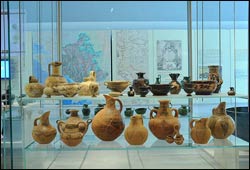
The Athens National Archeological Museum has a double anniversary this year – 180 years since its foundation and 120 years since it opening. Because of this, on the last floor of the museum, five exhibitions were prepared, which reveal the ancient world in micrographs – Eros, the Goddess Nike and dancers, the charm of theatre, the fine finesse of glass and gold.
2000 objects, most of which are displayed for the first time, represent the full collection of the museum. The collection of 20 clay figurines from Tanagra is remarkable. They depict different scenes – soldiers on chariots and women, who are watching them secretly from behind their fans, Eros lying down and beautiful young women with tiaras. Displayed are also children toys as well as Vlastos family’s collection, donated in 1980 and it is finally available for the public to see. Together with all those treasures displayed is also the oldest theatrical play depiction, which shows the audience, the director and the stage.
Mr. Nikos Kalzas – director of the National Archeological Museum shares that the visitors must pay special attention to the clay busts - found in tombs and also to all objects, which show the ancient world of micrography and especially the depictions of everyday living scenes – women baking bread, group of actors playing, etc. Very interesting are also the objects from Kerameykos and Anavisos and the collection from Karaditza.
You have to pay attention to the veined rapa whelk from Taranto, which is displayed separately – in the ancient years from those types of rapa whelks people used to obtain crimson color with which they dyed their clothes. Do not miss also the white pitchers found in Pangrati and also the glass bottle, which strangely survived in a sunk ship found next to Antikitira Island.
The National Archeological Museum was established by Kapodistria during 1829 and is the first State archeological museum. It used to be housed in Egina and when the capital moved to Athens, the museum did too. The problem with space was solved by Eleni Toshica who donated a piece of land, which is next to the Polytechnic University. The museum was built by architect Ludwig Lang, the blueprints were revised by Panagis Kalos but the final word was the one of Ernesto Chiler.